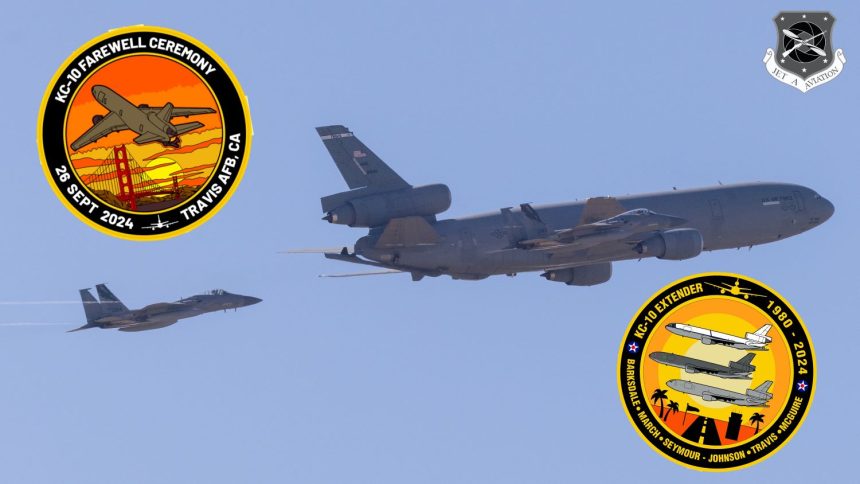The final KC-10A flies to the boneyard after a 44-year career while the USAF and lawmakers continue to debate the replacement tanker.
On Sept. 26, 2024, the U.S. Air Force finished the final chapter in the book on McDonnell Douglas KC-10A operations.
In a two-day event, Travis Air Force Base’s 60th Air Mobility Wing and 349th Air Mobility Wing (Air Force Reserve Command) hosted a ceremony featuring an aircraft tour, commemorative patches and t-shirts, and a speech by keynote speaker General Paul Selva (Ret.), the former Vice Chairman of the Joint Chiefs of Staff. Callsign GUCCI 10, tail number 79-1948, ended the event with a formation departure with two F-15C Eagle fighters of the California Air National Guard’s 144th Fighter Wing.
On the flight to her new home in the desert, GUCCI 10 was scheduled to make a pass over Long Beach, California (KLGB), the factory where the KC-10 fleet was built. However, it appears that in the end the pass over the factory did not happen.
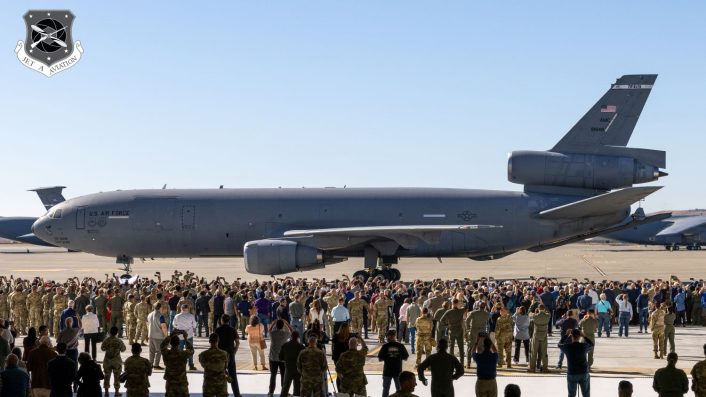
The KC-10’s story
The story of the KC-10 began during the Vietnam War as the U.S. Air Force began to stretch its KC-135 Stratotanker fleet thin with both deployments to Southeast Asia and with home-station nuclear alert taskings. Desperate for more tankers, the Advanced Tanker Cargo Program was born, with entries from McDonnell Douglas (DC-10), Boeing (747), and Lockheed (L-1011 and C-5). The competition was narrowed down to McDonnell Douglas and Boeing with the DC-10 trijet winning out.
McDonnell Douglas’ entry boasted a maximum fuel load of 356,000 pounds (161,479 kg), a cargo capacity of 170,000 pounds (77,111 kg) across 27 pallet positions, and the ability to carry 75 passengers. It would have a crew of four with two pilots, a flight engineer, and a boom operator. The jet also shared 88% parts commonality with the commercial DC-10. Picked because of its ability to operate from shorter runways than the 747, the newly-christened KC-10A Extender would take to the skies for the first time on July 12, 1980. Travis has operated the KC-10 since 1994.
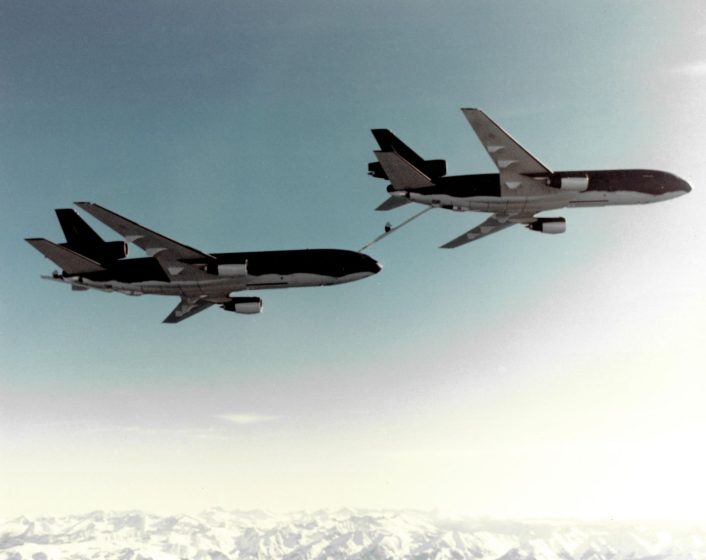
The airplane featured both a boom and a centerline drogue, making it capable of refueling both fellow USAF aircraft and those of the U.S. Navy and Marine Corps and allied nations. The last twenty KC-10s produced were also equipped with Wing Air Refueling Pods (WARP) near the wingtips that enabled it to refuel more than one probe-equipped receiver at a time. Over her service life, the KC-10 earned many nicknames, including “Gucci” and “Big Sexy”. She lived up to the names.
The KC-10 has gone on to serve in twelve U.S. engagements since, from Operation El Dorado Canyon to Operation Enduring Freedom. The airplanes have played a heavy role in projecting American airpower across the globe. In recent years, as part of the Global War on Terror and Operation Inherent Resolve, the KC-10s deployed frequently to the Central Command (CENTCOM) area of responsibility at places like Prince Sultan Airbase, Saudi Arabia, and Al Dhafra Airbase, United Arab Emirates.
79-1948, GUCCI10, landing at Davis-Monthan to go into AMARG for storage. This is the final KC-10. pic.twitter.com/CiscTYIWgs
— Steven Fortson (@zaphod58) September 27, 2024
The retirement
Only three of the recently-retired Extenders have ended up in museum collections: one each at the National Museum of the U.S. Air Force, the Air Mobility Command Museum, and the March Field Air Museum. The rest of the jets have been mothballed in the “boneyard” at Davis-Monthan AFB, Arizona. The airplanes may still find a new home, though, as previous Air Mobility Command (AMC) Commander General Mike Minihan recently confirmed the U.S. Air Force is exploring selling the retired refuelers to commercial air refueling companies, such as Omega Air Refueling. Omega currently operates former-Royal Netherlands Air Force KDC-10s (and a converted DC-10 formerly of Japan Airlines) along with KC-707s.
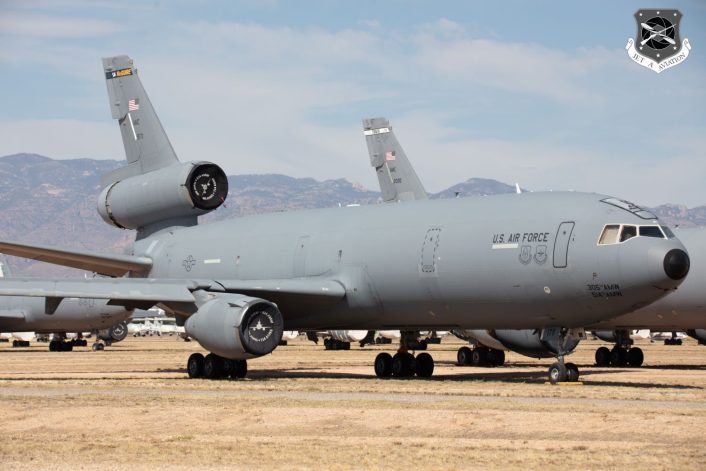
“As a KC-10 flyer myself, it has been amazing to watch the global impact this aircraft has had,” said Colonel Jay Johnson, 60th Air Mobility Wing Commander in a press release. “As we take the time to appreciate the legacy and history of the KC-10, we also have an opportunity to look forward to the future of tanker operations. I am excited to watch the same sense of pride and community build as we transition to the next generation of tanker operations.”
The KC-10’s intended replacement, Boeing’s KC-46A Pegasus, now takes the reins at both Travis AFB, California, and McGuire AFB, New Jersey, among other bases. McGuire AFB had previously retired their Extender fleet in August, 2023. The future of the KC-46, however, is something that’s been intensely debated since the KC-X program concluded in 2008 with the U.S. Air Force choosing Airbus / Northrop Grumman’s KC-30 (A330 MRTT), a decision that Boeing successfully protested and had the result changed in their favor in 2011. The Air Force has flirted with the idea of supplementing or even replacing the KC-46 as issues arise and costs soar.
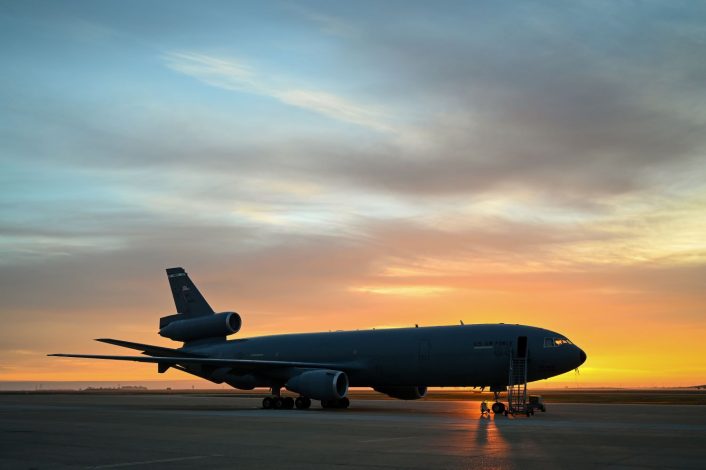
Travis AFB’s 9th and 70th Air Refueling Squadrons were the last to fly the Extender. The base is also home to the Lockheed C-5M Super Galaxy and Boeing C-17A Globemaster III airlifters.
And, Gucci, from a KC-135 guy… you’ll be missed. NKAWTG.

